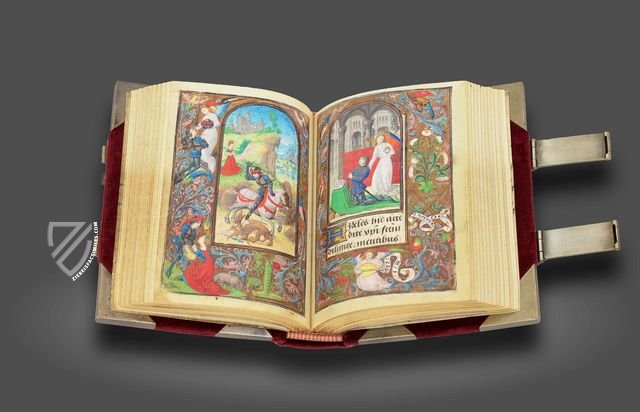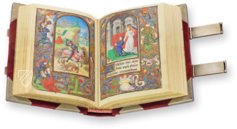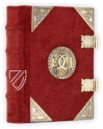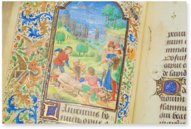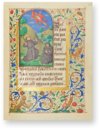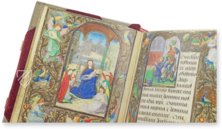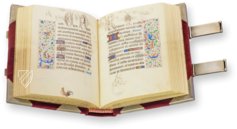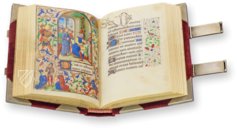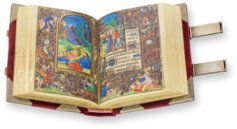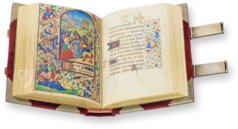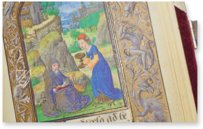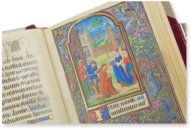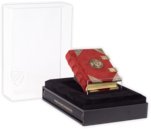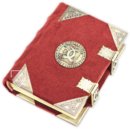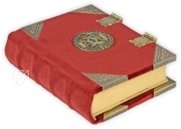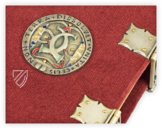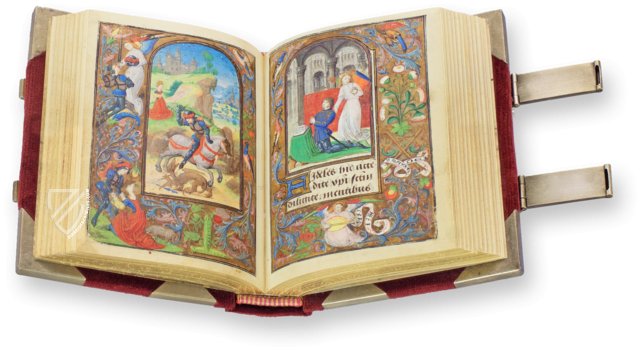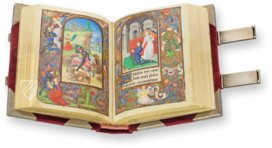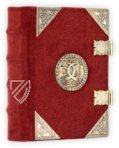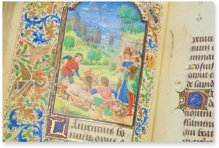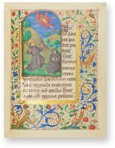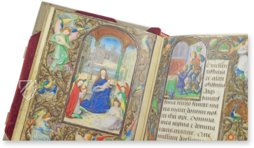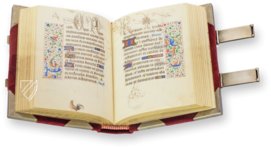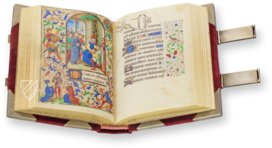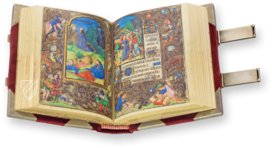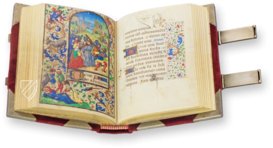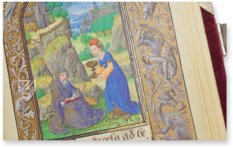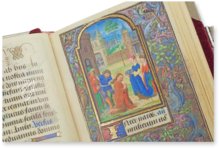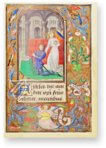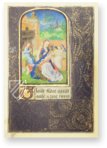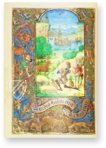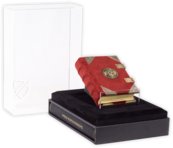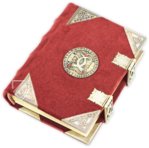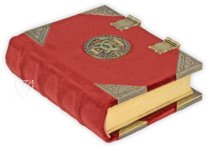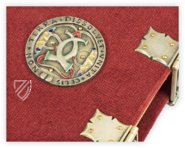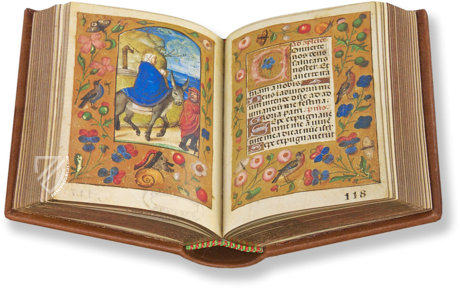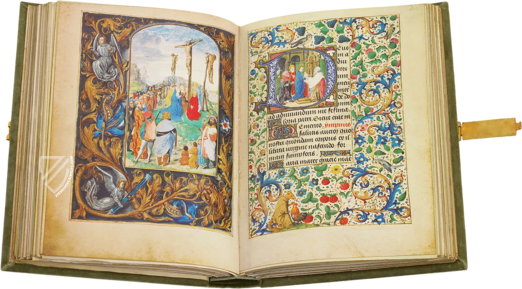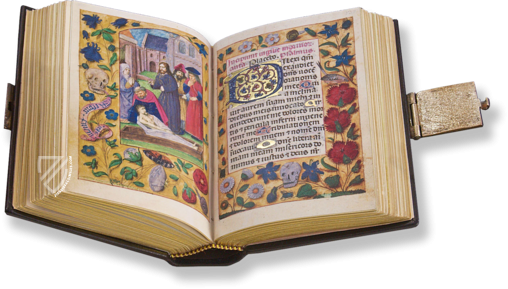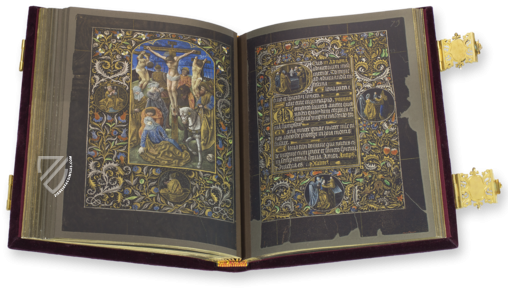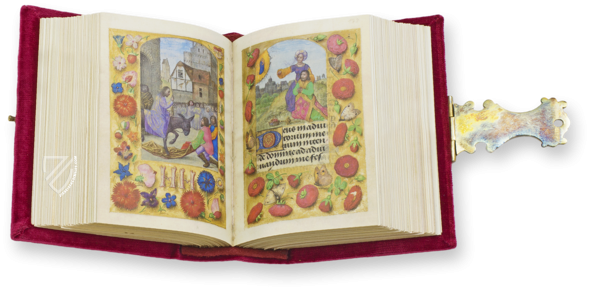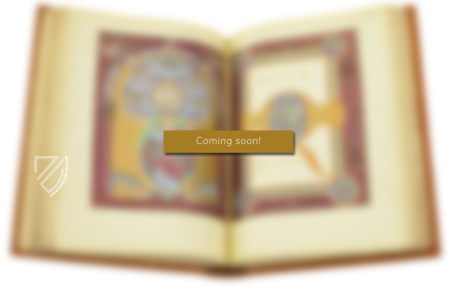Prayer Book of Charles the Bold
(1,000€ - 3,000€)
During the 15th century, the widely known court of the Dukes of Burgundy was an sophisticated center for art and culture in Europe, where various Netherlandish and Flemish artists were extensively patronized. The elaborate Prayer Book of Charles the Bold emerged in Flanders between 1469 and 1490 as a result of several stages of work involving some of the most gifted illuminators of the time – including the court painter Lieven van Lathem (c. 1430–1493) and the Vienna Master of Mary of Burgundy (fl. 1460–1480). It is one of the principal works of Early Netherlandish book art and occupies a special position in the transition between Gothic and Renaissance styles in Northern Europe. Every page of this small book treasure is incomparably lavishly illuminated with splendid colors and sumptuous gold leaf, including 47 wonderful miniatures, more than 360 decorated initials and opulently and fantastically designed borders. The participating illuminators revolutionized European illumination with their tender natural depictions and their realistic figures with expressive faces.
Prayer Book of Charles the Bold
Among all of the gorgeous, precious manuscripts produced by Flemish book art, the Prayer Book of Charles the Bold occupies a key position. It is an absolute principle work of the Renaissance. On 318 vellum pages, the small codex contains 47 miniatures and over 360 embellished initials against a background of engraved gold. Embellished with exuberant gold adornment, the work was elucidated by Charles’ favorite illuminator, Lieven van Lathem and his famous calligrapher Nicolas Spierinc and was furnished with numerous initials adorned with floral or figurative depictions. Three portraits of the commissioner attest to the very personal relationship Charles had with his prayer book.
A Masterpiece for the Burgundian Court
Charles the Bold, Duke of Burgundy, was a vibrant personality. He was simultaneously the last and the most famous duke from the house of Valois-Burgundy. The Burgundian Court became one of the most magnificent ruling seats in all of Europe during the reign of Charles. He was a passionate benefactor of the arts and has gone down in history as a lover of luxury and collector of great artistic treasures. Charles had numerous codices completed that were begun during the reign of his father Philipp the Good. As a patron, he was extremely demanding with respect to the works that were made for him. His inclination towards magnificence is reflected in his prayer book. Every page of the small book shows the splendor of Flemish illumination in an imaginative variety.
Flemish Book Art in its Utmost Perfection
During the time of the booklet’s creation, the Belgian region of Flanders near Paris was the creative center of illumination in Europe. The Belgian illuminators were able to successfully bring tender, natural observations such as unbelievably realistic facial features and gestures in representations of people to paper. With their innovative ideas and new artistic incentives, they inspired such great Dutch panel painters such as Jan van Eyck and Rogier van der Weyden, who were revolutionizing painting worldwide during the same period. Lieven van Lathem – court painter to Philipp the Good, his son Charles the Bold, and eventually Kaiser Maximillian as well – was one of the leading Flemish illuminators of that time. He was a valued member of the Illuminator’s Guild of Ghent and was later accepted into the famous St. Luke’s Guild in Antwerp. His atmospheric landscapes and made him a model for countless successive artists. He presented his talent in the small prayer book in a breath-taking manner. For the design of the precious work, he was supported by several additional masters, who exact identity cannot be proved with certainty. Yet one of them must have been the so-called Vienna Master of Maria of Burgundy. Researchers speculate that Alexander Benning, the father of the famous artist Simon Benning, hid behind this pseudonym. He is responsible for the design of the fine, animated figures and lively faces in the prayer book.
An Enchanting Story in Pictures
The Prayer Book of Charles the Bold contains 47 miniatures in an exuberantly colorful splendor and are embellished with gold. The pictures demonstrate the limitless imagination and narrative joy of their illuminators. There is imaginative bordure adornment on nearly every page of the work. Acanthus vines and other growing plants in lively, luminous colors with gold flowers, countless depictions of fantastical creatures, people, and animals all enliven the page margins. Alongside these enchanting depictions, three royal portraits of the commissioner, Charles, are to be found in the book. These portraits corroborate the personal nature of the prayer book. The text of the manuscript is also richly illuminated. The meticulously-written script was arranged through the 360 initials against at least partially tooled gold backgrounds.
Codicology
- Alternative Titles
- Le livre de prières de Charles Téméraire
Gebetbuch Karls des Kühnen - Size / Format
- 318 pages / 12.4 × 9.2 cm
- Origin
- Belgium
- Date
- 1469, ca. 1471 and ca. 1480–1490
- Epochs
- Style
- Genre
- Language
- Illustrations
- 47 miniatures, more than 360 initials. Each page decorated.
- Patron
- Charles The Bold, Duke of Burgundy (1433–1477)
- Artist / School
- Lieven van Lathem (illuminator)
Viennese Master of Mary of Burgundy (illuminator)
Possibly Alexander Bening (illuminator)
Nicolas Spierinc (scribe) - Previous Owners
- Marie de Luxembourg, Connétable of Saint-Pol (1472–1547)
Jeanne d'Albret (1528–72)
Marie Jeanne de Chaussy (b. 1767)
Paul Delaroche (1797–1856)
Count Paul Durrieu (1855–1925)
Jean Durrieu (1901–75)
Prayer Book of Charles the Bold
St. Hubertus
Hubertus was an 8th century Frankish nobleman who withdrew from court to find solace hunting in the woods after the death of his wife in childbirth. While pursuing a magnificent stag on Good Friday, the animal stopped and looked at him. Hubert then had a vision of a crucifix floating between its antlers and the deer spoke to him, calling him to a godly life. The deer is often used as a symbol of renewal in art because it sheds its antlers and is associated with Christ.
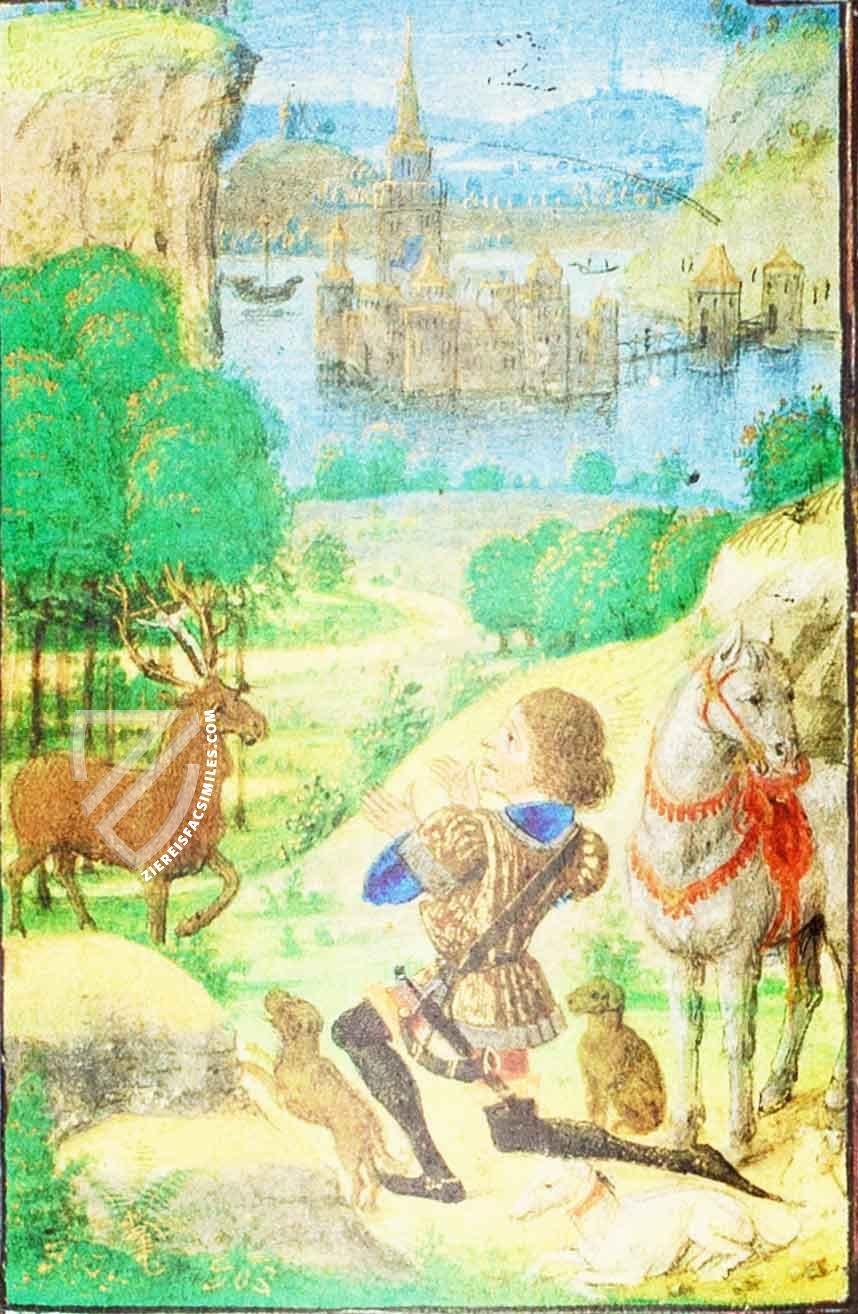
Prayer Book of Charles the Bold
Charles the Bold Presented by an Angel
Surrounded by an ornate frame filled with flowering tendrils, birds, banderoles, and an angel playing a lute, we find a miniature patron portrait of Duke Charles the Bold of Burgundy. He is kneeling before a codex, likely meant to represent his newly completed commission, in a scene that is typical in late medieval personal manuscripts.
This interior scene occurs within a cathedral, which is not portrayed in the contemporary Gothic style but in the older Romanesque with rounded arches and columns. Girt with a sword, the Duke’s legs are protected by plate armor, his brilliant blue tunic highlighted with pen strokes of gold ink. Standing behind Charles with a hand on his shoulder, the angel’s multicolored wings contrast with its pale tunic.
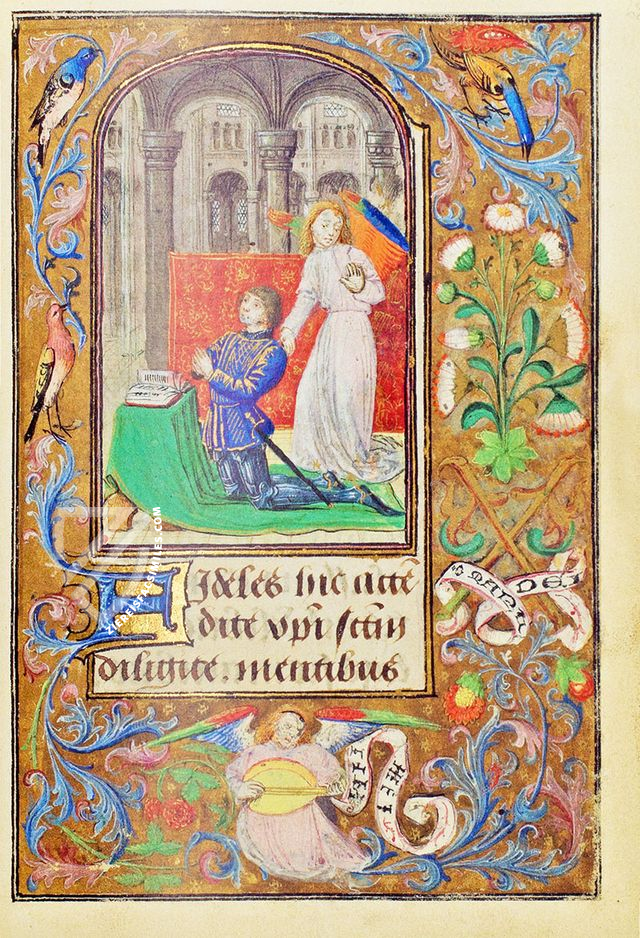
#1 Gebetbuch Karls des Kühnen
Languages: French, German
(1,000€ - 3,000€)
- Treatises / Secular Books
- Apocalypses / Beatus
- Astronomy / Astrology
- Bestiaries
- Bibles / Gospels
- Chronicles / History / Law
- Geography / Maps
- Saints' Lives
- Islam / Oriental
- Judaism / Hebrew
- Single Leaf Collections
- Leonardo da Vinci
- Literature / Poetry
- Liturgical Manuscripts
- Medicine / Botany / Alchemy
- Music
- Mythology / Prophecies
- Psalters
- Other Religious Books
- Games / Hunting
- Private Devotion Books
- Other Genres
- Afghanistan
- Armenia
- Austria
- Belgium
- Belize
- Bosnia and Herzegovina
- China
- Colombia
- Costa Rica
- Croatia
- Cyprus
- Czech Republic
- Denmark
- Egypt
- El Salvador
- Ethiopia
- France
- Germany
- Greece
- Guatemala
- Honduras
- Hungary
- India
- Iran
- Iraq
- Israel
- Italy
- Japan
- Jordan
- Kazakhstan
- Kyrgyzstan
- Lebanon
- Liechtenstein
- Luxembourg
- Mexico
- Morocco
- Netherlands
- Palestine
- Panama
- Peru
- Poland
- Portugal
- Romania
- Russia
- Serbia
- Spain
- Sri Lanka
- Sweden
- Switzerland
- Syria
- Tajikistan
- Turkey
- Turkmenistan
- Ukraine
- United Kingdom
- United States
- Uzbekistan
- Vatican City
- A. Oosthoek, van Holkema & Warendorf
- Aboca Museum
- Ajuntament de Valencia
- Akademie Verlag
- Akademische Druck- u. Verlagsanstalt (ADEVA)
- Aldo Ausilio Editore - Bottega d’Erasmo
- Alecto Historical Editions
- Alkuin Verlag
- Almqvist & Wiksell
- Amilcare Pizzi
- Andreas & Andreas Verlagsbuchhandlung
- Archa 90
- Archiv Verlag
- Archivi Edizioni
- Arnold Verlag
- ARS
- Ars Magna
- ArtCodex
- AyN Ediciones
- Azimuth Editions
- Badenia Verlag
- Bärenreiter-Verlag
- Belser Verlag
- Belser Verlag / WK Wertkontor
- Benziger Verlag
- Bernardinum Wydawnictwo
- BiblioGemma
- Biblioteca Apostolica Vaticana (Vaticanstadt, Vaticanstadt)
- Bibliotheca Palatina Faksimile Verlag
- Bibliotheca Rara
- Boydell & Brewer
- Bramante Edizioni
- Bredius Genootschap
- Brepols Publishers
- British Library
- C. Weckesser
- Caixa Catalunya
- Canesi
- CAPSA, Ars Scriptoria
- Caratzas Brothers, Publishers
- Carus Verlag
- Casamassima Libri
- Centrum Cartographie Verlag GmbH
- Chavane Verlag
- Christian Brandstätter Verlag
- Circulo Cientifico
- Club Bibliófilo Versol
- Club du Livre
- CM Editores
- Collegium Graphicum
- Collezione Apocrifa Da Vinci
- Comissão Nacional para as Comemorações dos Descobrimentos Portugueses
- Coron Verlag
- Corvina
- CTHS
- D. S. Brewer
- Damon
- De Agostini/UTET
- De Nederlandsche Boekhandel
- De Schutter
- Deuschle & Stemmle
- Deutscher Verlag für Kunstwissenschaft
- DIAMM
- Droz
- E. Schreiber Graphische Kunstanstalten
- Ediciones Boreal
- Ediciones Grial
- Ediclube
- Edições Inapa
- Edilan
- Editalia
- Edition Deuschle
- Edition Georg Popp
- Edition Leipzig
- Edition Libri Illustri
- Editiones Reales Sitios S. L.
- Éditions de l'Oiseau Lyre
- Editions Medicina Rara
- Editorial Casariego
- Editorial Mintzoa
- Editrice Antenore
- Editrice Velar
- Edizioni Edison
- Egeria, S.L.
- Eikon Editores
- Electa
- Emery Walker Limited
- Enciclopèdia Catalana
- Eos-Verlag
- Ephesus Publishing
- Ernst Battenberg
- Eugrammia Press
- Extraordinary Editions
- Fackelverlag
- Facsimila Art & Edition
- Facsimile Editions Ltd.
- Facsimilia Art & Edition Ebert KG
- Faksimile Verlag
- Feuermann Verlag
- Folger Shakespeare Library
- Franco Cosimo Panini Editore
- Friedrich Wittig Verlag
- Fundación Hullera Vasco-Leonesa
- G. Braziller
- Gabriele Mazzotta Editore
- Gebr. Mann Verlag
- Gesellschaft für graphische Industrie
- Getty Research Institute
- Giovanni Domenico de Rossi
- Giunti Editore
- Graffiti
- Grafica European Center of Fine Arts
- Guido Pressler
- Guillermo Blazquez
- Gustav Kiepenheuer
- H. N. Abrams
- Harrassowitz
- Harvard University Press
- Helikon
- Hendrickson Publishers
- Henning Oppermann
- Herder Verlag
- Hes & De Graaf Publishers
- Hoepli
- Holbein-Verlag
- Houghton Library
- Hugo Schmidt Verlag
- Idion Verlag
- Il Bulino, edizioni d'arte
- ILte
- Imago
- Insel Verlag
- Insel-Verlag Anton Kippenberger
- Instituto de Estudios Altoaragoneses
- Instituto Nacional de Antropología e Historia
- Introligatornia Budnik Jerzy
- Istituto dell'Enciclopedia Italiana - Treccani
- Istituto Ellenico di Studi Bizantini e Postbizantini
- Istituto Geografico De Agostini
- Istituto Poligrafico e Zecca dello Stato
- Italarte Art Establishments
- Jan Thorbecke Verlag
- Johnson Reprint Corporation
- Josef Stocker
- Josef Stocker-Schmid
- Jugoslavija
- Karl W. Hiersemann
- Kasper Straube
- Kaydeda Ediciones
- Kindler Verlag / Coron Verlag
- Kodansha International Ltd.
- Konrad Kölbl Verlag
- Kurt Wolff Verlag
- La Liberia dello Stato
- La Linea Editrice
- La Meta Editore
- Lambert Schneider
- Landeskreditbank Baden-Württemberg
- Leo S. Olschki
- Les Incunables
- Liber Artis
- Library of Congress
- Libreria Musicale Italiana
- Lichtdruck
- Lito Immagine Editore
- Lumen Artis
- Lund Humphries
- M. Moleiro Editor
- Maison des Sciences de l'homme et de la société de Poitiers
- Manuscriptum
- Martinus Nijhoff
- Maruzen-Yushodo Co. Ltd.
- MASA
- Massada Publishers
- McGraw-Hill
- Metropolitan Museum of Art
- Militos
- Millennium Liber
- Müller & Schindler
- Nahar - Stavit
- Nahar and Steimatzky
- National Library of Wales
- Neri Pozza
- Nova Charta
- Oceanum Verlag
- Odeon
- Orbis Mediaevalis
- Orbis Pictus
- Österreichische Staatsdruckerei
- Oxford University Press
- Pageant Books
- Parzellers Buchverlag
- Patrimonio Ediciones
- Pattloch Verlag
- PIAF
- Pieper Verlag
- Plon-Nourrit et cie
- Poligrafiche Bolis
- Presses Universitaires de Strasbourg
- Prestel Verlag
- Princeton University Press
- Prisma Verlag
- Priuli & Verlucca, editori
- Pro Sport Verlag
- Propyläen Verlag
- Pytheas Books
- Quaternio Verlag Luzern
- Reales Sitios
- Recht-Verlag
- Reichert Verlag
- Reichsdruckerei
- Reprint Verlag
- Riehn & Reusch
- Roberto Vattori Editore
- Rosenkilde and Bagger
- Roxburghe Club
- Salerno Editrice
- Saltellus Press
- Sandoz
- Sarajevo Svjetlost
- Schöck ArtPrint Kft.
- Schulsinger Brothers
- Scolar Press
- Scrinium
- Scripta Maneant
- Scriptorium
- Shazar
- Siloé, arte y bibliofilia
- SISMEL - Edizioni del Galluzzo
- Sociedad Mexicana de Antropología
- Société des Bibliophiles & Iconophiles de Belgique
- Soncin Publishing
- Sorli Ediciones
- Stainer and Bell
- Studer
- Styria Verlag
- Sumptibus Pragopress
- Szegedi Tudomànyegyetem
- Taberna Libraria
- Tarshish Books
- Taschen
- Tempus Libri
- Testimonio Compañía Editorial
- Thames and Hudson
- The Clear Vue Publishing Partnership Limited
- The Facsimile Codex
- The Folio Society
- The Marquess of Normanby
- The Richard III and Yorkist History Trust
- Tip.Le.Co
- TouchArt
- TREC Publishing House
- TRI Publishing Co.
- Trident Editore
- Tuliba Collection
- Typis Regiae Officinae Polygraphicae
- Union Verlag Berlin
- Universidad de Granada
- University of California Press
- University of Chicago Press
- Urs Graf
- Vallecchi
- Van Wijnen
- VCH, Acta Humaniora
- VDI Verlag
- VEB Deutscher Verlag für Musik
- Verlag Anton Pustet / Andreas Verlag
- Verlag Bibliophile Drucke Josef Stocker
- Verlag der Münchner Drucke
- Verlag für Regionalgeschichte
- Verlag Styria
- Vicent Garcia Editores
- W. Turnowski Ltd.
- W. Turnowsky
- Waanders Printers
- Wiener Mechitharisten-Congregation (Wien, Österreich)
- Wissenschaftliche Buchgesellschaft
- Wissenschaftliche Verlagsgesellschaft
- Wydawnictwo Dolnoslaskie
- Xuntanza Editorial
- Zakład Narodowy
- Zollikofer AG

